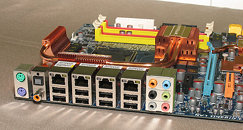Monday, June 9th 2008

Computex 2008: GIGABYTE GA-EP45-DQ6 - First motherboard with 4x Gigabit Ethernet
As the name suggests, the GIGABYTE GA-EP45-DQ6 is based on Intel's new P45 chipset. What makes this board special is that it supports four Gigabit Ethernet ports, with an optional teaming feature. While this feature is only of limited use for desktop users, it becomes interesting when building a powerful office or LAN party server. Also included is a TPM chip which is becoming more and more useful in the business world, and might even make it onto gaming PCs for the use of game copy protection.


38 Comments on Computex 2008: GIGABYTE GA-EP45-DQ6 - First motherboard with 4x Gigabit Ethernet
if you used all 4 of those ports... you would need to do some funky things to actually get a working network for gaming. You'd need static IP's on every system within the same range, and bridge all four ports on the main system - a switch would be simple plug and play assuming you had a DHCP server such as a router. also, if any network cable was unplugged windows kills the bridge, and so on.
it just gets more and more complicated for every device added in, as you simply are adding more points to choke performance or cause complications.
Tkpenalty: please give us examples since you claim to know people who would use this. I cant come up with anything beyond uses for two ports.
one for the xbox,
one for the missus pc
one for the kids pc upstairs.
all 4 used :D
You get a little more control when they're attached to a computer, and you can do more interesting things than with a switch or a router, but I don't see a big advantage of having so many. If you want them, why not buy a dual gigabit or a couple of single cards and get a regular motherboard?
My biggest point of confusion with this board....... why dual x16 slots, 4x NICs, and no integrated video? It requires a dedicated graphics card, and from the cooling is positioned at the enthusiast market, but all the uses we've come up with so far really have nothing to do with apps that need a dedicated card? It seems like they've spread the board across several sectors, and made something which doesn't really excel at any one set of tasks.
Also, I'm not sure when teeming would be useful on a board like this. The only way to really saturate a single gigabit line would be a large RAID array, you may need a dedicated card just to saturate one, let alone 2 or 4. It's an interesting idea for a desktop board, but I just don't see how this setup would be optimal for any one situation.....
If and when games makers start using it, I give it a week before it's useless.
was the first as i Have that board
Problem with teaming is that it takes a switch that supports it properly. Otherwise only certain teaming modes are available. For a LAN party I wouldn't bother with it either.
You do realise that by default these four ports are not linked in any way. if you run one of these for your internet... the other ports wont do anything. you'll just get unknown network errors, no IP addresses and so on.